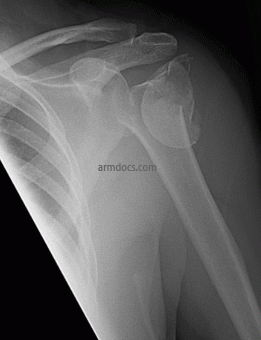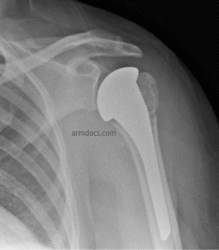How is the procedure performed?
The operation is performed under a combination of general and regional anaesthesia. The shoulder is exposed, the humeral head (ball fragment) is removed and a metal prosthesis is implanted in the shaft of the humerus. The tuberosities (bone fragments which carry tendon attachments) are realigned and then fixed to the prosthesis and humeral shaft with sutures or cable. The fixation is supplemented with bone grafting using bone from the removed fragment.
Benefits
A hemiarthroplasty usually renders the shoulder relatively pain free and allows the use of the arm. If the tuberosities heal in a good position, this usually allows return of useful function in the shoulder.
Risks
Medical complications
Chest infection, Deep vein thrombosis, Pulmonary embolism, Myocardial infection are possible after surgery.
Surgical complications
Infection: This can occur after any operation where metal devices are implanted in the body. Several measures are employed to minimize the risk of infection including administration of antibiotics prior to the operation, an antiseptic technique and the use of a clean air theatre.
Nerve injury: This is possible but rare.
Bleeding : Bleeding may occur during or after surgery. A blood transfusion is rarely required. In very rare instances a blood vessel may be damaged as a consequence of injury or surgery.
Tuberosity failure: If the bone is weak due to osteoporosis, the fixation of the tuberosities may fail leading to tuberosity migration. This will inevitably compromise the function of the shoulder. In some instances the bone of the tuberosities may disappear over time.
Tuberosity malunion: Sometimes the tuberosities may heal in an abnormal position. In some instances the shoulder may continue to function well despite this but if function is affected then further surgery may be considered.
Stiffness: This is not uncommon following injury and surgery. In most instances it will resolve as you start moving the arm with the aid of physiotherapy. If stiffness persists beyond 9-12 months then further surgery may be considered to treat the stiffness.
Rotator cuff failure: This is a consequence of wear and tear of the rotator cuff tendons and can occur even in the absence of injury.
Instability: The shoulder may dislocate after surgery but this is rare.
Periprosthetic fracture: The shaft of the humerus may fracture during the course of the operation or if there is a further injury after the operation.
Glenoid erosion: In some instances over a period of time, the cartilage (gristle) on the socket of the shoulder may wear leading to pain.
Revision: If the artificial joint, the tuberosities or the rotator cuff fail or if the joint becomes painful due to glenoid erosion then further surgery may be necessary to exchange the joint.
Aftercare
Following the procedure the surgical wound is covered with a shower-proof dressing. The dressing should be left undisturbed as far as possible for 14 days. If the dressing is removed for any reason they should be replaced with similar dressing or waterproof plaster. Prior to discharge from hospital a physiotherapist will provide instructions about looking after the shoulder. You will be advised to protect the shoulder by wearing a sling and intermittently performing movements of the shoulder within certain limits. You will be encouraged to move the elbow, wrist and hand to prevent stiffness. After 4-6 weeks you may stop wearing the sling and will be allowed to move the shoulder actively through a greater range. You may resume driving when you have regained control of the arm. This may take anywhere between 8-16 weeks. Strengthening exercises are started after 12 weeks or once the fracture has healed. Vigorous use of the arm or lifting heavy objects should be avoided for at least 3 months. Outpatient physiotherapy will be arranged and may need to be continued for 6-12 months.
Follow-up
An appointment will be arranged for you to be seen between 2 and 6 weeks after the procedure. Follow-up is required for at least 6 months after surgery or until a satisfactory recovery is achieved. X-rays will be performed at intervals to monitor tuberosity healing.


